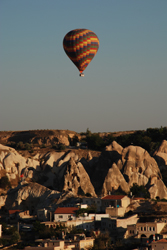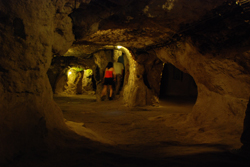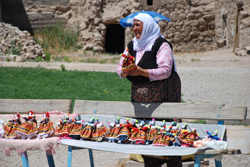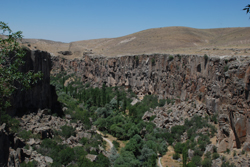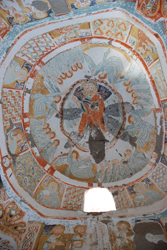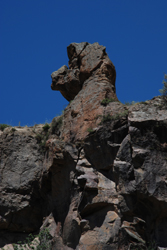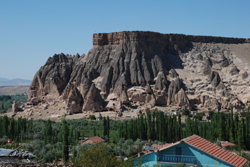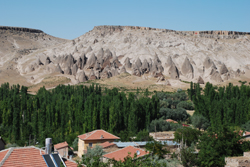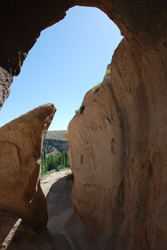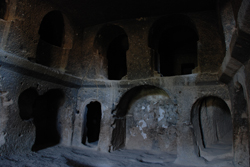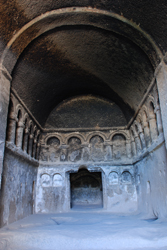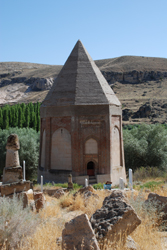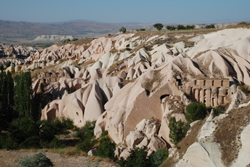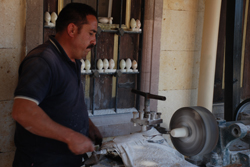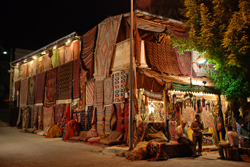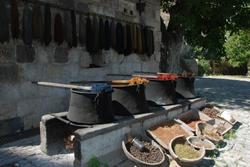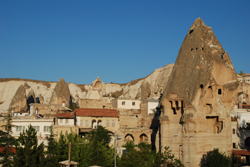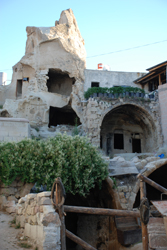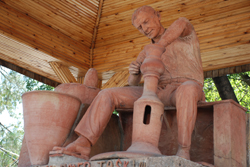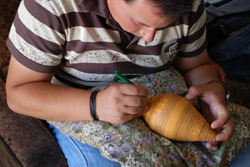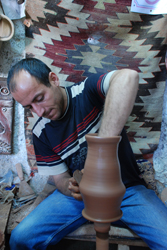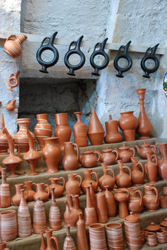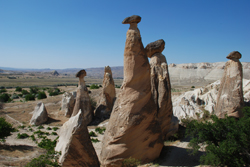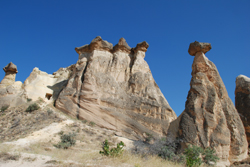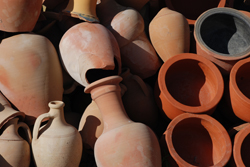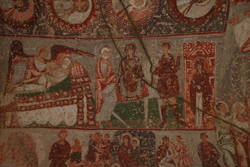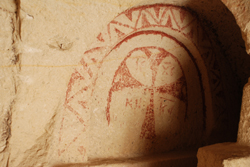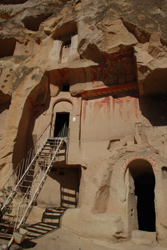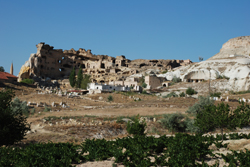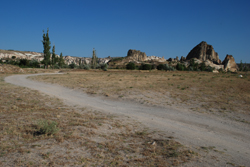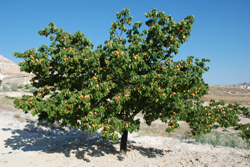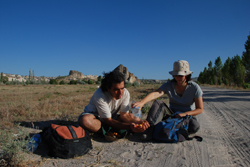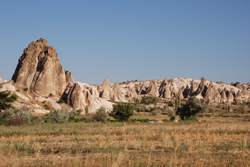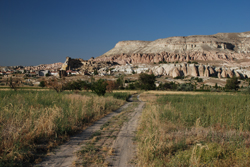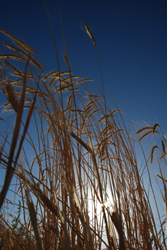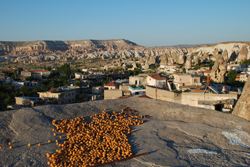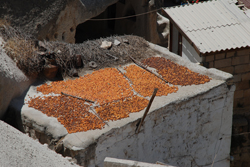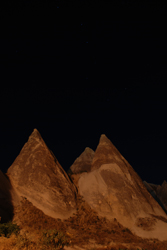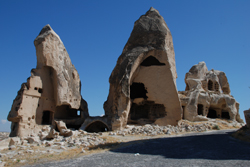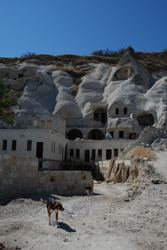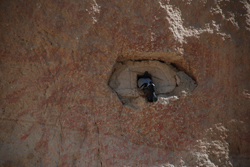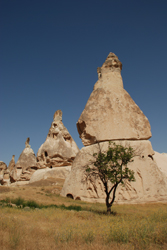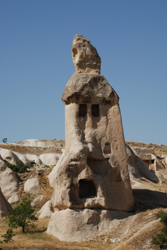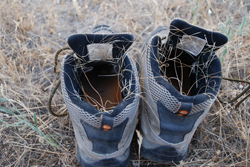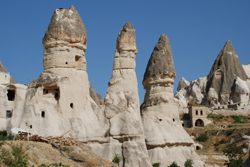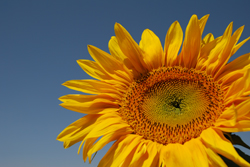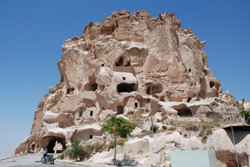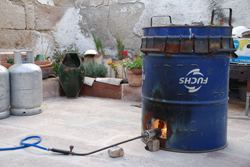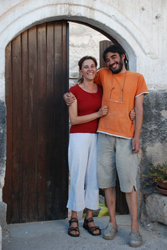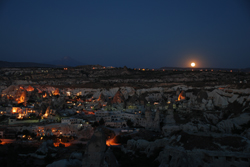Cappadocia: Visiting the Goreme Open Air Museum
20 July, 2008, 05:47 am in "Turkey"
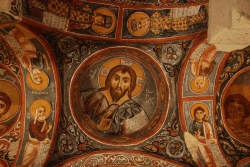 Hoping to beat the tour groups, we hurriedly left the hotel around 8:30. It was already warm as we walked the 1 km to get to the Open Air Museum. We were, unfortunately, passed by a couple tour buses. We made our way up the hill, avoiding an arrowed sign "To Goreme Open Air Museum" which directed unwary readers on a detour through a row of shops, restaurants, souvenir stands, and a camel contentedly munching on a pile of hay.
Hoping to beat the tour groups, we hurriedly left the hotel around 8:30. It was already warm as we walked the 1 km to get to the Open Air Museum. We were, unfortunately, passed by a couple tour buses. We made our way up the hill, avoiding an arrowed sign "To Goreme Open Air Museum" which directed unwary readers on a detour through a row of shops, restaurants, souvenir stands, and a camel contentedly munching on a pile of hay.Once in the museum area, we skipped the first church because it was full of a tour group. The museum was a series of wide based white cone-shaped rock towers. Carved holes led inside. Some had simple painted decorations marking doors and windows. We followed the cobblestone path to another rock tower. A narrow tunnel led through the rock to another tiny church: also full of a tour group. Speeding on, we managed to get ahead of the tour groups and get inside some of the rock churches. The dark interiors had barrel vaults and rough domes carved into the rock. Some had the remains of frescoes that looked simple but well done. Other parts of the walls were decorated with simple red lines and ornaments that looked, in contrast to the other frescoes, child-like.
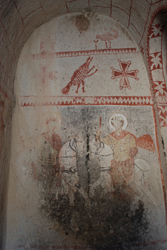
One room had a long table and benches carved into the stone.
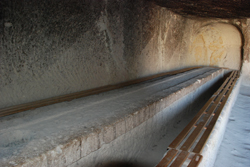
Some of the interiors had carved columns and alcoves.
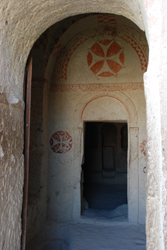
We looked at a couple other churches with highly damaged fresco remains. Then we approached the "Dark Church"--named so because it was lit by just one tiny window. We had to pay extra but it was worth it. This church was covered with well preserved frescoes in Byzantine style. Christ Pantocrator looked down from the domes. The walls were filled with pictures from Jesus' life.
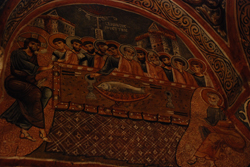
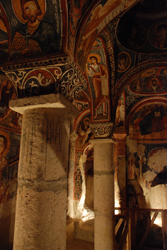
At one point the walls had been entirely covered with pictures. Strangely out of place were the black and white columns decorated with wavy lines that looked straight out of 70s psychadelia.
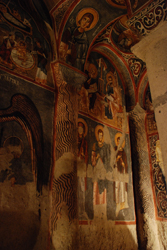
We spent a long time in the church expecting to be forced out at any minute by a tour group. But, none came. There had only been 2 people there when we walked in and only 3 more walked in and out while we were there. We enjoyed leisurely looking at the paintings and relaxing in the cool darkness. Outside we could hear the loud voices of groups going by but none came in. It turned out that the tour groups tend to skip the finest church in the complex.
Outside, we managed to visit the churches we had skipped due to crowds. They didn't seem too amazing after the "Dark Church" though. Since we had been moving around so slowly, the tour groups eventually disappeared, leaving the museum quiet and empty.
We made a final stop at the Tocali Church which also had fine walls of frescoes. This church was bigger and had a crypt underneath.
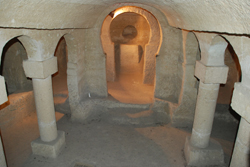
In the church, I realized why churches were decorated with both finely painted frescoes and rough line patterns. In Tocali, it was evident that originally, the church had been decorated with pigment lines and patterns. Eventually, this was covered with plaster and the more sophisticated frescoes were painted. There seemed to be 2 types of the sophisticated frescoes in the church as well-- one which included simpler images with broader strokes, while the other looked closer to the Byzantine mosaics with more delicate subtleties in fabric and features.
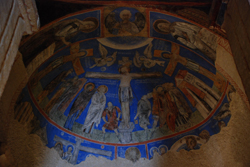
Back into the sun, we walked to "Love Valley" (Zemi Valley), named for the presence of rather narrow vertical fairy chimneys that looked more like a part of masculine anatomy than anything a fairy would light a fire underneath. We walked between the rocks, then up a hill/rock ridge, that separated the valley from Goreme.
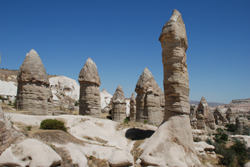
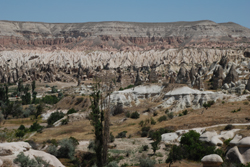
We ended up spending a lot of time our last day, hanging out at the motel. R played backgammon with some of the guys there and chatted. They were kind enough to let us even though we had technically checked out in the morning. Rowshan also made friends with one of the neighborhood kids who eagerly showed him his bicycle.
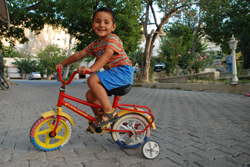
Cappadocia: Tour to the Underground City and Ilhara Valley
19 July, 2008, 08:08 am in "Turkey"
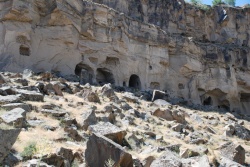 Today Rowshan woke up early to take photos of the hot air balloons.
Today Rowshan woke up early to take photos of the hot air balloons.Then, we finally managed to go on the tour to the Ilhara Valley. There were 15 of us in the group hailing from Canada, the US, France and Korea. We started out at a viewpoint of Goreme where the mountain was visible faintly etched into the sky in the distance. There, our guide told us about the formation of Cappadocia: volcanic action filling the valley with ash which was compressed into layers of basalt or tufa. Then erosion created rippling hills and "fairy chimney" formations, tall slender towers that are the famous landmarks of Cappadocia. Then we headed to Derinkuyu. I had been there before with my parents. It was interesting to note that when I went before, the guide explained the city was discovered when a woman's chicken disappeared and since she could hear it below her, she dug until she came to the city caverns. This time our guide said that the chicken story was just a story and the city was actually discovered by archaeologists. He said not much is known about who made it since it was used strictly during wars so people brought what they needed when they hid there but brought it all back out to their regular houses after the threat was over, leaving no artifacts. We saw the upper levels: kitchen and stables, as well as several lower levels including the 7th level built in the 10th Century which contained a church, and the 1 room 8th level.
We traveled through low tunnels and down long narrow staircases, saw ventilations shafts, millstone doors (used in case of intruders reaching the inside of the city), and a well. Outside we passed up several offers for dolls.
The next stop was for a brief hike in the Ilhara valley which seemed like a green tear in the dry golden land above it.
It was a pretty canyon whose rock walls revealed cave churches, shelters and pigeon houses. We visited a small painted church with yellow and red fragments of frescoes.
We walked alongside a small river lined with cypress trees. The river cooled the valley, as did the spots of shade provided by the trees. It was a little like Mission Gorge in San Diego. We couldn't help noticing a rock formation that looked like a sheep's or pig's head.
Lunch was at a kebab place on the river in the town of Belisirma. We sat on a deck thought there were platforms with cushions set up in the river itself, like the restaurants at the foot of the mountain in Tehran.
Our guide rushed us off to Selime Monastery: a monastery built into fairy chimneys which was near an area that some tours falsely claim to have been the set for Star Wars.
We climbed up rock stairs and trails to the complex which included kitchens, a watch tower, many other rooms, a cathedral, church, and chapel.
There were a few sections, including the chapel, with carvings and the Cathedral was filled with dark frescoes. I don't know if they had all originally been black and orange but the remains seemed to be all black with just a few parts in orange. Our guide said the monastery had also been used as a caravansary but I think he was just covering for the fact that we didn't go see the caravansary that the other tours go to. Below the monastery was a small tomb.
It was a long drive back and the tour finished with a stop at Pigeon Valley, probably more as an excuse to go to the Onyx jewelry and stone carving factory.
Here we got the same carved onyx egg demo I saw 8 years ago.
We were also told the same way to identify real turquoise that I was told by them 8 years ago: break a chip off it. I'm about as skeptical of the feasibility of this technique as I was 8 years ago.
Cappadocia: The Stone Village of Goreme , Avanos Ceramics, and the Cave Church of Cavusin
18 July, 2008, 08:08 am in "Turkey"
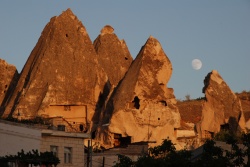 We arrived in Goreme around noon and took a room in the first hotel we walked into, The Blue Moon. It had a good price and looked new and clean. It is not a cave, the traditional form of housing in Cappadocia, but I didn't feel like looking at a bunch of different caves trying to find one with nice air circulation.
We arrived in Goreme around noon and took a room in the first hotel we walked into, The Blue Moon. It had a good price and looked new and clean. It is not a cave, the traditional form of housing in Cappadocia, but I didn't feel like looking at a bunch of different caves trying to find one with nice air circulation. Goreme is a tourist town. It seems entirely made up of tourist amenities: hotels, restaurants, tour agents, and souvenir stands. It has that odd atmosphere of a small town invaded by tourists: like you're in a Disneyland version of reality, the Turkey that the tourists want Turkey to be.
In spite of this, the town has a lot of attractive features: the towering rock pinnacles and carved stone houses.
But many of the caves and houses seem to be crumbling under the weight of tourist feet and time.
After much debating we decided on a tour of the Ilhara Valley tomorrow, then a 3 day tour to Mt. Nemrut. With these plans taken care of, we decided to give Rowshan his ceramics fix and go to Avanos.
The bus ride passed lots of characteristic Cappadocia landscapes: sculpted rock towers, wind shaped hills with stripes of creams, tans, and salmon. It looks like an occupied version of the Badlands in South Dakota: places where settlers took one look and said, "No Way!" and moved on to greener places leaving ominous names like "Devil's Canyon", or "Dead-man's Gulch" behind.
The pottery workshops of Avanos are used to tourists.
In fact, they seemed to be more shops than workshops with rooms full of wares, much coming from Kutahya or Iznik. In the first one we went into, we were whisked off to a showroom and offered a chance to watch someone throw something using a kick wheel or watch people decorate pieces. The finest quality looking pieces were from Kutahya and Iznik and since we've been to both of those places now, there wasn't much point in spending time in a showroom. The Avanos pieces are courser and more utilitarian pieces, more often painted than glazed. Even though the intricate designs were pretty, similar in style and color to Ancient Greek animalistic style, due to the cheapness of paint instead of glaze, they wouldn't have lasted long.
The next couple studios were a little more laid back. We got a wheel throwing demonstration (the wheel was electric) and R chatted about pottery with the guys working. It seemed like this studio was at least a working studio and the guy at the wheel did a very good job at throwing a vase.
At the last studio the artist was doing something original, swirling light and red clays together in tiny pieces.
We caught the bus back towards Goreme but got off halfway, in the town of Cavusin where we had noticed some interesting rocks as well as some ceramics shops.
We walked through the towers and into a carved out pigeon coop in one of the hills.
Cavusin also had an ancient painted church carved inside a rock face. There were several different rooms. The most impressive one had walls and ceilings completely covered with paintings representing scenes from the bible. Most of the faces on the lower walls had been gouged out. Those on the ceiling remained.
We walked back towards Goreme, taking a dirt road for a better look at some of the stone towers. Rowshan raced off to take pictures of some of the cave riddled rocks while I sat in the road in the shade of the trees lining it.
About 15 minutes later, he came running up with a hat full of apricots he'd picked from a tree.
We enjoyed a snack, then continued on to town.
Even though it was getting towards evening,it was still hot. While walking around town, we met some local women. First they waved at us as we walked by. I waved back. When we walked by again, they gestured us over. They were sitting in the golden early evening light wearing shalvar pants and white veils. They asked us if we wanted to buy any of the white scarves. We said no. Rowshan was looking for a view and one woman offered to show us her house which had a good view. I knew this meant we'd have to buy something from her. Her home was a traditional cave house with the rooms carved out of the rock. She showed us to her roof where apricots were drying in the sun. Several other roofs also held golden apricots in various stages of drying.
She sold R a white beaded head scarf which he made use of the next evening by soaking in ice water and draping it on his forehead in an attempt to reduce the fever he had from heat exhaustion.
We made an effort to find a restaurant locals went to go but were unsuccessful. They definitely do not go to the kebab place we had dinner at, which gave me a nasty bout of food poisoning, which wiped me out for the next 2 days. After that unfortunate meal, we walked to a residential area (but didn't see any businesses).
I did see a huge spider. Seeing me staring, and following the huge creature around the road, a woman ran out of one of the houses and smashed it with her slipper. She said it was a scorpion but I think it was a spider since it didn't have a tail. It did have very nasty jaws.
Goreme is such a strange place. It is full of ruins but you can't tell how old they are because the new buildings are built the same way. The ruins are left, broken towers of rock with exposed caverns, piles of stone, and new houses are carved into the rock.
Even the newer houses look like they have parts that have fallen down or been repaired. I wonder if there are any building codes regulating cave houses. I wonder if one day it will all be ruins and no one will live here but the pigeons.
Day #2 in Goreme-- I spent in bed while Rowshan went off to Urgup seeking fairy chimneys. He returned via Uchisar and hiked through Pigeon Valley in the hot sun, returning to the hotel with a bad case of heat exhaustion.
Day #3 We had to cancel our trip to Nemrut due to our respective illnesses. Rowshan spent the day puking and feverish. I managed to eat breakfast and go to the market next door. I spent the rest of the day sleeping, reading, and doing computer stuff. In the evening I took another short walk.
Day #4 We both are feeling better and have managed to eat breakfast and take a walk.
While visiting the Argos gift shop net door to the hotel, R learned about a local potter doing high fire, fine art ceramics. The Argos is owned by Mehmet, who was originally a professional musician but who has had the shop for 9 years. He also makes lether work. R was attracted to it because of the beautiful contemporary ceramics pieces. It is more of a gallery than a souvenir shop with handpicked samples of work from artists in Cappadocia.
The pieces at the Argos are works of art and I felt that Mehmet was doing something important for arts in the region by encouraging a higher level of quality. The Avanos pieces are finer than the pieces I saw in the workshops in Avanos. He also had a beautiful set of plates with designs similar to the intricate Greek type designs we'd seen painted on pieces in Avanos, but here they were glazed, guaranteeing the pieces would last. M put R in contact with Tayfun Kucukcan (tolseramik.com). We arranged to meet him and his wife towards evening in Avanos.
Tayfun and Nilgun live in a village house with an open courtyard. The first thing we noticed was a handmade gas kiln roaring off of 2 Aygaz tanks.
Tayfun explained it was for raku. Nilgun, also does ceramics but focuses more on sculpture. She originally is from Istanbul. We all chatted a bit then R and I had to run off to catch the last bus back to Goreme.
In the evening we walked up to a panoramic point and watched the moon rise.
[ View 1 Comments
|
]


